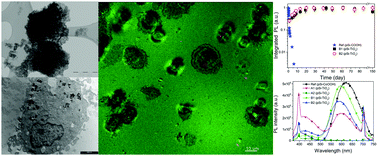当前位置:
X-MOL 学术
›
J. Mater. Chem. B
›
论文详情
Our official English website, www.x-mol.net, welcomes your
feedback! (Note: you will need to create a separate account there.)
TiO2-coated luminescent porous silicon micro-particles as a promising system for nanomedicine†
Journal of Materials Chemistry B ( IF 6.1 ) Pub Date : 2018-02-16 00:00:00 , DOI: 10.1039/c7tb02614e E. Chistè 1, 2, 3, 4, 5 , A. Ghafarinazari 1, 2, 3, 4, 5 , M. Donini 4, 5, 6, 7, 8 , V. Cremers 9, 10, 11, 12, 13 , J. Dendooven 9, 10, 11, 12, 13 , C. Detavernier 9, 10, 11, 12, 13 , D. Benati 4, 8, 14, 15, 16 , M. Scarpa 5, 17, 18, 19, 20 , S. Dusi 4, 5, 6, 7, 8 , N. Daldosso 1, 2, 3, 4, 5
Journal of Materials Chemistry B ( IF 6.1 ) Pub Date : 2018-02-16 00:00:00 , DOI: 10.1039/c7tb02614e E. Chistè 1, 2, 3, 4, 5 , A. Ghafarinazari 1, 2, 3, 4, 5 , M. Donini 4, 5, 6, 7, 8 , V. Cremers 9, 10, 11, 12, 13 , J. Dendooven 9, 10, 11, 12, 13 , C. Detavernier 9, 10, 11, 12, 13 , D. Benati 4, 8, 14, 15, 16 , M. Scarpa 5, 17, 18, 19, 20 , S. Dusi 4, 5, 6, 7, 8 , N. Daldosso 1, 2, 3, 4, 5
Affiliation

|
Porous silicon (pSi) is a sponge-like material obtained by electrochemical etching of a crystalline silicon wafer. Due to quantum confinement effects, this material is photoluminescent and this is a fundamental property from the perspective of bioimaging applications. Limitations in nanomedicine to the use of photoluminescent pSi structures are mainly due to optical quenching in an aqueous environment and to the adverse effects of reactive groups introduced by etching procedures. In this work, we exploited an inorganic TiO2 coating of pSi microparticles by Atomic Layer Deposition (ALD) that resulted in optical stability of pSi particles in a biological buffer (e.g. PBS). The use of a rotary reactor allows deposition of a uniform coating on the particles and enables a fine tuning of its thickness. The ALD parameters were optimized and the photoluminescence (PL) of pSi–TiO2 microparticles was stabilized for more than three months without any significant effect on their morphology. The biocompatibility of the coated microparticles was evaluated by analyzing the release of cytokines and superoxide anion (O2−) by human dendritic cells, which play an essential role in the regulation of inflammatory and immune responses. We demonstrated that the microparticles per se are unable to significantly damage or stimulate human dendritic cells and therefore are suitable candidates for nanomedicine applications. However, a synergistic effect of the microparticles with bacterial products, which are known to stimulate immune-response, was observed, indicating that a condition unfavorable to the use of inorganic nanomaterials in biological systems is the presence of infection diseases. These results, combined with the proved PL stability in biological buffers, open the way for the use of pSi–TiO2 microparticles as promising materials in nanomedicine, but their ability to increase immune cell activation by other agonists should be considered and even exploited.
中文翻译:

TiO 2包覆的发光多孔硅微粒作为纳米医学的有前途的体系†
多孔硅(pSi)是通过对晶体硅晶片进行电化学蚀刻而获得的海绵状材料。由于量子限制效应,这种材料是光致发光的,从生物成像应用的角度来看,这是一种基本特性。纳米医学中使用光致发光pSi结构的局限性主要是由于在水性环境中发生的光淬灭以及蚀刻工艺引入的反应性基团的不利影响。在这项工作中,我们通过原子层沉积(ALD)开发了pSi微粒的无机TiO 2涂层,该涂层导致了pSi微粒在生物缓冲液中的光学稳定性(例如PBS)。旋转反应器的使用可以在颗粒上沉积均匀的涂层,并可以对其厚度进行微调。优化了ALD参数,pSi-TiO 2微粒的光致发光(PL)稳定了三个月以上,而对其形态没有任何显着影响。涂覆的微粒的生物相容性通过分析细胞因子的释放并评价超氧阴离子(O 2 - )由人树突细胞,从而起到的炎症和免疫应答的调节中起重要作用。我们证明了微粒本身不能显着损害或刺激人树突状细胞,因此是纳米药物应用的合适候选者。然而,观察到微粒与已知刺激免疫应答的细菌产物的协同作用,表明存在在生物系统中不利于使用无机纳米材料的条件是感染疾病的存在。这些结果,再加上在生物缓冲液中已证明的PL稳定性,为将pSi-TiO 2微粒用作纳米药物中的有希望的材料开辟了道路,但应考虑甚至利用它们增强其他激动剂激活免疫细胞的能力。
更新日期:2018-02-16
中文翻译:

TiO 2包覆的发光多孔硅微粒作为纳米医学的有前途的体系†
多孔硅(pSi)是通过对晶体硅晶片进行电化学蚀刻而获得的海绵状材料。由于量子限制效应,这种材料是光致发光的,从生物成像应用的角度来看,这是一种基本特性。纳米医学中使用光致发光pSi结构的局限性主要是由于在水性环境中发生的光淬灭以及蚀刻工艺引入的反应性基团的不利影响。在这项工作中,我们通过原子层沉积(ALD)开发了pSi微粒的无机TiO 2涂层,该涂层导致了pSi微粒在生物缓冲液中的光学稳定性(例如PBS)。旋转反应器的使用可以在颗粒上沉积均匀的涂层,并可以对其厚度进行微调。优化了ALD参数,pSi-TiO 2微粒的光致发光(PL)稳定了三个月以上,而对其形态没有任何显着影响。涂覆的微粒的生物相容性通过分析细胞因子的释放并评价超氧阴离子(O 2 - )由人树突细胞,从而起到的炎症和免疫应答的调节中起重要作用。我们证明了微粒本身不能显着损害或刺激人树突状细胞,因此是纳米药物应用的合适候选者。然而,观察到微粒与已知刺激免疫应答的细菌产物的协同作用,表明存在在生物系统中不利于使用无机纳米材料的条件是感染疾病的存在。这些结果,再加上在生物缓冲液中已证明的PL稳定性,为将pSi-TiO 2微粒用作纳米药物中的有希望的材料开辟了道路,但应考虑甚至利用它们增强其他激动剂激活免疫细胞的能力。











































 京公网安备 11010802027423号
京公网安备 11010802027423号